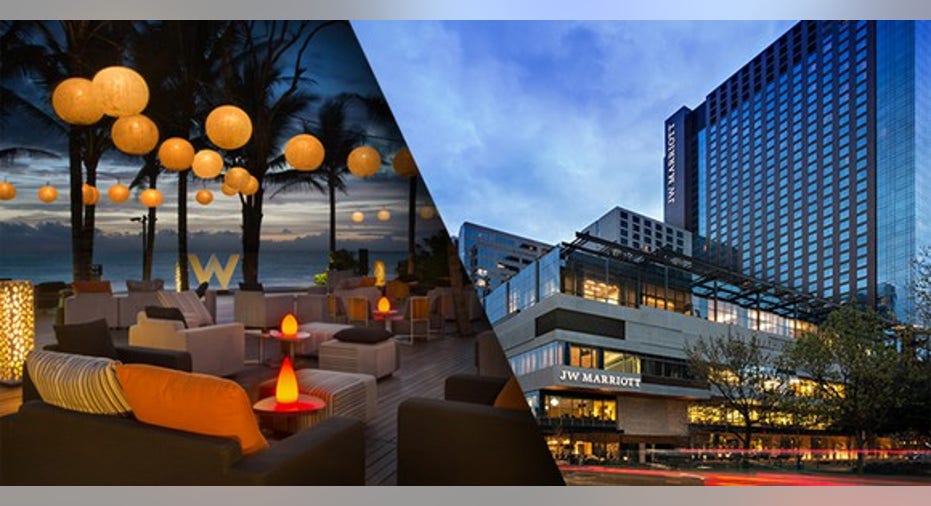3 Areas to Watch as Marriott International Becomes the World's Largest Hotel Company

Image source: Marriott
"Welcome to the new Marriott portfolio of hotels. Starwood Hotels & Resorts and Marriott International have joined to become the world's largest hotel company -- and that means exciting new things for you," reads an email sent to Marriott International (NASDAQ: MAR) and Starwood Hotels and Resort members following the successful merger of the two companies on Friday.
Chinese officials formally approved the Marriott-Starwood merger last week, the final hurdle the deal announced last November had to clear. This nearly $14 billion combination is the largest hotel company in the world both by market cap and number of properties. What management plans to do with this mammoth company, and the roadblocks they might face, will have major impacts for shareholders in the coming months and years.
Dealing with duplicates
One of the most important parts of the merger financially is the estimated $250 million in annual synergy cost savings, according to the management teams. Much of that will come from salary savings as top executives are cut. Most lower-level employees will likely keep their jobs, as the day-to-day operations of both companies properties won't change. However, there will be no need for two CEOs, nor for many other positions at the executive level. How Marriott management deals with this structural change could have lasting impacts on how the cultures of the two companies mesh.
Then there are the combined 30 hotel brands that now live together under one umbrella: Will Marriott continue to support so many brands operating within the same sub-segments? Marriott CEO Anne Sorenson has said he doesn't plan to get rid of any brands, telling USA Today, "We think we're advantaged and our customers are advantaged by having more choice, not less." Marriott could still end up closing some of the poorer performers in each portfolio and transitioning their names to the better performing ones in the future, but at least for the near term, this is one area where duplication will remain.
Merging loyalty programs
Marriott Rewards has some 56 million members, while Starwood Preferred Guest (SPG) has around 21 million (though the amount of overlap for consumers in both programs is unknown). Marriott CEO Arne Sorenson has said that SPG was one of the main reasons Marriott fought so hard to buy Starwood.
Image source: Marriott
In the near term, Marriott plans to run its loyalty programs separately; full integration is unlikely to happen before 2018. Instead, management said they will be "building bridges between the programs to enhance customer experience." Marriott has already implemented a way for loyalty program members of either side to link accounts, allowing them to transfer points from one program to the other and match whichever program the customer has a higher status in. Marriott calls this "the best of all worlds," as consumers now have full access to both programs as they choose.
The long-term vision for the combined programs includes new co-branded bank cards, expanded partnerships, and more options for all members. If Marriott can successfully merge the programs without much resistance, the combined loyalty program could be one of the hotelier's most important assets because of the data it will provide about consumers' travel preferences. A truly robust loyalty program should also help to drive more members to book directly with Marriott rather than through a third party, something that could help to drive higher sales.
Negotiating better terms with e-booking sites
Speaking of third-party booking agents, one way this merger could generate higher profits is by leveraging its now-greater strength in its relationships with e-booking site such as those owned by Priceline Group (NASDAQ: PCLN) and Expedia (NASDAQ: EXPE). These services generally take a percentage of the sale for matching travelers with their hotel choice. That's revenue that Marriott would like to get back.
Marriott now has 5,700 properties on six continents. Its more than 1.1 million rooms are nearly 50% more than the now second-largest hotelier, Hilton Worldwide (NYSE: HLT). With that much inventory, Marriott will have more power to negotiate better terms for a lower percentage taken by these third-party booking sites. Even a small decrease in the percentage that Priceline or others take could significantly improve Marriott's total revenue.
Foolish takeaway: Marriott is a solid bet
There are plenty of headwinds facing the lodging industry, including slowing GDP growth in the U.S., which can lead to lower corporate travel demand; geopolitical and terrorism concerns worldwide that keep some customers from traveling; and the rise of disruptors like Airbnb. Regardless of these factors, Marriott looks like a buy now for its long-term growth potential, thanks in part to this successful merger with Starwood. It's for these and other reasons that Morgan Stanley and Goldman Sachs analysts have each upgraded the stock following the completion of the acquisition, projecting as much as 20% upside for Marriott stock.
A secret billion-dollar stock opportunity The world's biggest tech company forgot to show you something, but a few Wall Street analysts and the Fool didn't miss a beat: There's a small company that's powering their brand-new gadgets and the coming revolution in technology. And we think its stock price has nearly unlimited room to run for early in-the-know investors! To be one of them, just click here.
Seth McNew owns shares of Marriott International. The Motley Fool owns shares of and recommends Marriott International and Priceline Group. Try any of our Foolish newsletter services free for 30 days. We Fools may not all hold the same opinions, but we all believe that considering a diverse range of insights makes us better investors. The Motley Fool has a disclosure policy.



















